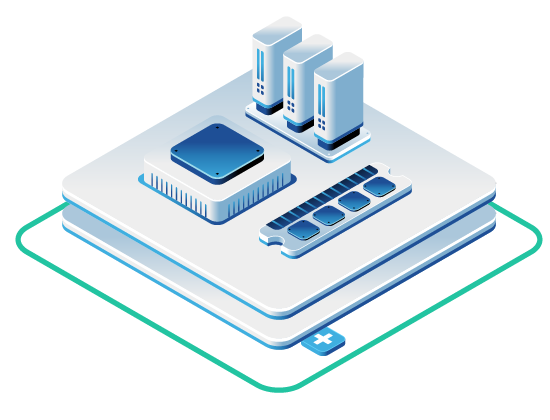In this article
- Related Video: Value Driven OpenStack & Ceph Clouds
- Cost Benefits of Ceph’s Scaling Options
- Single Platform for Multiple Storage Types
- Data Protection and Storage Efficiency
- Setting Up Ceph for Private Clouds
- OpenMetal and Ceph
- Wrapping Up: Reducing Costs With Ceph
- Get Started on an OpenStack Hosted Private Cloud
Ceph is a software-defined storage platform that helps private clouds cut storage costs by up to 50% while maintaining reliability and performance. We’ll dig deeper into the details in this article, but here’s a quick rundown of how it delivers these savings:
- Commodity Hardware: Ceph runs on standard, off-the-shelf servers, eliminating the need for expensive proprietary systems.
- Unified Storage: Supports object, block, and file storage on one platform, reducing infrastructure complexity and costs.
- Data Compression: Compression can lower storage costs from $1.90/GB to $0.95/GB, depending on the level of compression.
- Erasure Coding: Saves space compared to traditional replication methods while ensuring data protection.
- Open Source: Avoid vendor lock-in and high maintenance fees with Ceph’s open source structure.
- Automation: Self-managing and self-healing features reduce administrative workloads and staffing costs.
Quick Comparison: Ceph vs. Traditional Storage
| Feature | Ceph EC4:2 | Ceph 3x Replication | Hadoop Distributed File System (HDFS) 3x Replication |
|---|---|---|---|
| Raw Storage for 1PB | 1.5PB | 3PB | 3PB |
| Cost Efficiency | Most efficient | Similar to HDFS | 2x more costly |
| Failure Tolerance | 2 OSDs | 2 OSDs | 2 OSDs |
| Speed (Mixed Workloads) | 48% slower | Similar to HDFS | Fastest |
Ceph’s scalability, cost efficiency, and automation make it a top choice for private clouds. Let’s get into how to optimize Ceph for your infrastructure and maximize savings.
Related Video: Value Driven OpenStack & Ceph Clouds
Cost Benefits of Ceph’s Scaling Options
Using Standard Hardware to Scale
Ceph makes it possible to expand storage using affordable, off-the-shelf hardware instead of pricier proprietary systems. This approach gives IT teams the freedom to select hardware that aligns with their performance needs and budget. To manage costs while scaling, organizations can take these steps:
- Configure RAID controllers in RAID 0 (JBOD) to reduce redundancy overhead.
- Set up pools with identical OSD hardware to ensure consistent performance.
- Separate cluster traffic from client traffic to preserve bandwidth.
These strategies help lower expenses while keeping performance intact.
Breaking Free from Vendor Dependencies
Ceph’s open source structure means you won’t be locked into expensive vendor contracts, offering organizations more control and flexibility. Traditional enterprise storage often ties businesses to specific vendors, which can inflate costs and limit options.
“The worldwide network behind Ceph ensures continual development, growth and improvement. Without the confines of a proprietary business model, Ceph’s community is free to create and explore, innovating outside of traditional development structures.” (Ceph.io)
Vendor lock-in can lead to hidden costs, such as:
- High maintenance fees and annual cost increases
- Reduced pricing negotiation leverage
- Slower adoption of new technology or industry innovations
- Added complexity from vendor-specific tools
Storage Costs: Ceph vs. Enterprise Systems
The cost advantages of Ceph extend to measurable savings in storage configurations. Here’s a closer look:
| Storage Configuration | Raw Storage Needed for 1PB Usable | Cost Efficiency |
|---|---|---|
| Ceph EC4:2 | 1.5PB | Most efficient |
| HDFS 3x Replication | 3PB | 2x more costly |
| Ceph 3x Replication | 3PB | Similar to HDFS |
While Ceph EC4:2 is 48% slower than HDFS in mixed workloads, its lower cost leads to a strong price-to-performance balance.
Organizations on OpenMetal’s Ceph-based infrastructure have reported up to 3.5x better efficiency compared to public cloud solutions. What’s driving this?
- Fixed hardware budgets with no surprise charges
- Predictable egress costs
- Smarter resource use
- Elastic provisioning capabilities
“OpenMetal Cloud provides on-demand private infrastructure, which brings cloud fundamentals like elasticity and usage billing to the cloud deployment itself. It’s awesome to see OpenMetal’s latest product use OpenStack to combine the benefits of public cloud and managed private cloud, powered by open infrastructure.”
– Thierry Carrez, VP of Engineering, OpenInfra Foundation
Single Platform for Multiple Storage Types
Replacing Multiple Storage Systems
Ceph’s unified storage design brings object, block, and file storage together on a single platform. This integration helps cut down on hardware, licensing, and maintenance expenses. It even provides S3-compatible APIs, which means it can mimic the functionality of AWS S3 and integrate with tools that use S3 storage.
It offers three storage interfaces:
- Block Storage via RBD
- File Storage via CephFS
- Object Storage via RGW
With Ceph’s tiered storage options, businesses can manage costs more effectively. Frequently accessed data can stay in high-performance pools, while less critical data is moved to more cost-efficient tiers. This setup lets companies strike a balance between performance and cost without needing multiple specialized systems. By consolidating storage, businesses not only save on equipment but also simplify day-to-day management.
Simpler Management Reduces Staff Costs
Ceph’s self-healing features and automation reduce the need for manual oversight. Plus, its unified management system lowers operational complexity overall. Here’s how it compares to traditional setups:
| Management Task | Traditional Systems | Ceph Unified Platform |
|---|---|---|
| Storage Provisioning | Multiple interfaces | Single management console |
| Data Migration | Complex cross-system transfers | Automated pool-based movement |
| Maintenance Windows | Separate for each system | Consolidated maintenance |
| Staff Training | Multiple specializations needed | Single, unified skill set |
Ceph’s unified system also offers:
- Centralized compliance
- Fewer network bottlenecks
- Automated redundancy
Data Protection and Storage Efficiency
Automatic Data Repair Features
Ceph is designed to handle data corruption and node failures automatically, minimizing downtime and lowering management costs. By spreading data across multiple nodes, it eliminates single points of failure.
When hardware issues occur, Ceph detects them, redistributes data to maintain redundancy, balances workloads, and repairs corrupted data – all without requiring administrator intervention. This automation reduces the time spent on maintenance tasks. Additionally, its advanced data distribution techniques help optimize storage usage.
Space-Saving With Erasure Coding
Ceph also offers erasure coding, a feature that reduces storage costs while ensuring data remains protected. Erasure coding works by breaking data into fragments and distributing both the data and coding chunks across the storage cluster. This both provides redundancy and saves space.
| Storage Method | Space Required for 1TB Data | Failure Tolerance |
|---|---|---|
| Default Replication | 2TB | 1 disk |
| Default Erasure Coding | 1.5TB | 1 disk |
| Advanced Erasure (10+4) | 1.4TB | 4 disks |
For instance, Sardina Systems implemented a Ceph cluster for GRASS MERKUR with a 6+3 erasure coding setup. This configuration achieved 67% storage efficiency on a 1.1 PB raw capacity, resulting in 691.2 TiB of usable space while maintaining data protection and cutting their costs by 24%.
The choice of erasure coding profile impacts both storage efficiency and data durability. A default profile, using k=2 and m=1, spreads data across three OSDs. In contrast, an advanced profile, like k=10 and m=4, allows for the loss of up to four OSDs while maintaining only a 40% storage overhead.
For organizations focused on cost savings, erasure coding is an excellent option for long-term archival storage. It’s particularly useful when data integrity and fault tolerance are critical, and read performance is less of a priority. Storage costs can start at $2/GB for smaller deployments (5TB) and drop as low as $0.20/GB for larger setups of 300TB. These strategies significantly lower costs, aligning with Ceph’s goal of making private cloud storage more economical.
Setting Up Ceph for Private Clouds
Ceph Installation Planning
To get the most out of your Ceph deployment, plan your hardware setup carefully. Use standard hardware with customized daemon configurations across multiple hosts to ensure strong performance and reliability.
Here’s a breakdown of the hardware requirements for each daemon type:
| Daemon Type | CPU | RAM | Storage | Network |
|---|---|---|---|---|
| OSD | 1x 64-bit dual-core | ~1GB per 1TB storage | 1 drive per daemon | 2x 1Gb Ethernet NICs |
| Monitor | 1x 64-bit dual-core | 3GB per daemon | 10GB minimum | 2x 1Gb Ethernet NICs |
| Manager | 1x 64-bit dual-core | 3GB per daemon | N/A | 2x 1Gb Ethernet NICs |
For example, a Dell PowerEdge R510 setup might include:
- 2x 64-bit quad-core Xeon CPUs
- 16GB RAM
- 8x 2TB drives (1 for the operating system, 7 for storage)
- Dual 1Gb Ethernet NICs
Once your hardware is ready, you can fine-tune your configuration to reduce costs without compromising performance.
Cost-Saving Setup Tips
Ceph already offers a budget-friendly solution, but these tips can help you save even more:
- Use separate drives for the operating system and OSDs, allocate 1GB of RAM per terabyte of storage, enable 9000 MTU for better network performance, and disable disk caches for improved reliability.
- Keep client and cluster networks separate for better traffic management.
Keith Tenzer, a prominent Solutions Architect with decades in the industry, emphasizes Ceph’s ability to help you save:
“Ceph is cost-effective. Ceph leverages Linux as an operating system instead of something proprietary. You can choose not only whom you purchase Ceph from, but also where you get your hardware.” (OpenInfra.org)
Connecting Ceph to OpenStack
After optimizing your Ceph deployment, you can integrate it with OpenStack to improve cloud operations. This connection helps streamline processes and boosts efficiency.
Here’s how to set up the key components:
- Glance Integration: Use separate pools for image storage to minimize network traffic.
- Cinder Setup: Create distinct storage pools for different service tiers, such as gold (SSD), silver (mixed), and bronze (HDD).
- Nova Configuration: Store virtual disk images in Ceph to eliminate the need for local storage.
For Glance, stick with the raw image format instead of QCOW2. Also, enable the RBD cache in the Ceph configuration file on each hypervisor to speed up read and write operations.
OpenMetal and Ceph
OpenMetal takes Ceph’s cost-saving potential even further with our private cloud solutions. All OpenMetal clouds come with Ceph-based block and object storage supplied by the Private Cloud Core (PCC). The S3-compatible Ceph object gateway is accessible independent of OpenStack or through OpenStack. This allows you to provision independent object storage deployments including 1+ petabytes on demand.
All private Cloud Cores come by default with Ceph configured to provide block storage that is backed by a triplicate copy of your data. Each server has at least one drive that is within a Ceph pool. The pool is then made available by Ceph to OpenStack for your VMs or containers to mount as block storage. In the event a server or drive becomes unavailable, your Ceph and the block storage will continue to work for your VMs using that storage.
With network block storage, live migration, the ability to move VMs between hardware nodes with one or two ping drops, is supported. This technology, though not often used, can be very valuable in maintaining a healthy cloud without disruptions to VM workloads.
With Ceph integrated into OpenStack, OpenMetal achieves cloud cost reductions of 30% to 60% compared to conventional options. For example, MyMiniFactory, a 3D printable model repository, found cost savings and performance improvements after migrating to OpenMetal. They faced challenges with unpredictable public cloud costs and performance limitations, and required lots of storage. OpenMetal’s solution resulted in a substantial decrease in monthly storage expenses, improved performance to handle their growing data, predictable budgeting due to the fixed-cost model, and better control over their infrastructure.
“We welcome OpenMetal’s unique method of charging on a consumption threshold flow basis for bandwidth and in relation to profitability we are pleasantly surprised with the monthly ongoing costs of using their infrastructure. They have been very agile and flexible in accommodating our rapid growth and aligning the contract with our planned growth.”
– Matt Weston (CFO) @ MyMiniFactory
Wrapping Up: Reducing Costs with Ceph
Key Takeaways
Ceph’s design not only simplifies storage but also drastically lowers expenses. By using commodity hardware, Ceph can reduce storage costs by up to 50% through compression.
Here’s how different data types benefit from Ceph’s compression:
| Data Type | Compression Ratio | Space Savings |
|---|---|---|
| Raw YUV Video | 3.13x | 68% |
| CSV/JSON Data | 1.33x | 25% |
| JPEG Images | 1.01x | 1% |
These figures highlight Ceph’s ability to support both performance and cost-effectiveness. Its unified storage system eliminates the need for separate setups, reducing both capital and operational expenses. Plus, Ceph’s self-managing and self-healing features help keep maintenance costs low while ensuring data reliability and availability.
Ceph is a great fit for just about any storage need. If you’d like to learn more or get started on Ceph, let’s talk!
Read More on the OpenMetal Blog


































